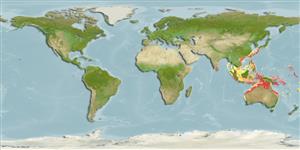>
Carangiformes (Jacks) >
Carangidae (Jacks and pompanos) > Caranginae
Etymology: Alepes: Greek, alepis, -idos = without scales (Ref. 45335).
Environment: milieu / climate zone / depth range / distribution range
Sinh thái học
Biển gần đáy; Mức độ sâu 5 - 80 m (Ref. 86942). Tropical
Western Central Pacific: endemic to northern Australia, from Exmouth Gulf, Western Australia to Wide Bay, Queensland.
Bộ gần gũi / Khối lượng (Trọng lượng) / Age
Maturity: Lm ? range ? - ? cm
Max length : 29.5 cm TL con đực/không giới tính; (Ref. 9894)
Các tia vây lưng cứng (tổng cộng) : 8; Các vây lưng mềm (tổng cộng) : 24 - 26; Tia cứng vây hậu môn: 3; Tia mềm vây hậu môn: 20 - 22; Động vật có xương sống: 24. This species is distinguished by the following characters: adipose eyelid well developed on posterior half of the eye only; upper jaw narrowly rounded posteriorly, with supramaxilla relatively small without an anterior spine-like extension; gill rakers (including rudiments) 8-10 + 18-21 = 27-30. Colour in life green to bluish green above, silvery to white below, a diffuse dusky blotch on margin of opercle, not bordered above by a white spot; interradial membranes of spinous dorsal fin hyaline to dusky; spinous and second dorsal, anal, and caudal fins dusky yellow, with anterior rays of second dorsal and anal fins often with white tips; caudal-fin lobes often with dark tips; pelvic fins white and pectoral fins hyaline; juveniles with 7 dark bands on body (Ref. 9894).
Adults occur in inshore waters of the continental shelf (Ref. 75154). Feeds primarily on small invertebrates, primarily microscopic crustaceans and molluscs. Caught mainly on hook-and-line (Ref. 9894).
Life cycle and mating behavior
Chín muồi sinh dục | Sự tái sinh sản | Đẻ trứng | Các trứng | Sự sinh sản | Ấu trùng
Smith-Vaniz, W.F., 1999. Carangidae. Jacks and scads (also trevallies, queenfishes, runners, amberjacks, pilotfishes, pampanos, etc.). p. 2659-2756. In K.E. Carpenter and V.H. Niem (eds.) FAO species identification guide for fishery purposes. The living marine resources of the Western Central Pacific. Vol. 4. Bony fishes part 2 (Mugilidae to Carangidae). Rome, FAO. 2069-2790 p. (Ref. 9894)
IUCN Red List Status (Ref. 130435: Version 2024-1)
Threat to humans
Harmless
Human uses
Các nghề cá: Tính thương mại
Các công cụ
Special reports
Download XML
Các nguồn internet
Estimates based on models
Preferred temperature (Ref.
123201): 24.5 - 28.7, mean 27.7 °C (based on 544 cells).
Phylogenetic diversity index (Ref.
82804): PD
50 = 0.5312 [Uniqueness, from 0.5 = low to 2.0 = high].
Bayesian length-weight: a=0.01318 (0.00626 - 0.02776), b=2.96 (2.79 - 3.13), in cm total length, based on LWR estimates for this (Sub)family-body shape (Ref.
93245).
Mức dinh dưỡng (Ref.
69278): 3.5 ±0.5 se; based on size and trophs of closest relatives
Thích nghi nhanh (Ref.
120179): Chiêù cao, thời gian nhân đôi của chủng quần tối thiểu là dưới 15 tháng (Preliminary K or Fecundity.).
Fishing Vulnerability (Ref.
59153): Low vulnerability (20 of 100).
